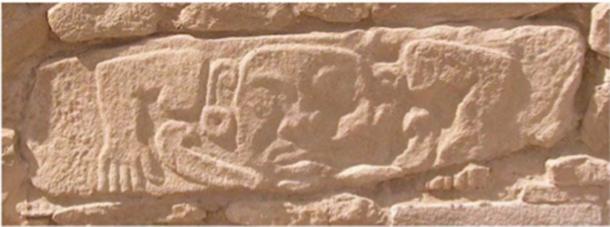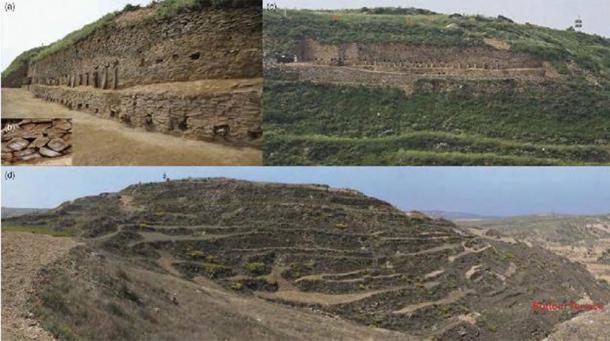Shimao is an ancient Chinese city that was lost for a long time. But in recent years it has yielded many of its secrets to archaeologists. Among the most astonishing finds are a step-pyramid and evidence of human sacrifice. The grisly discoveries are offering new insight into the origin of early Chinese civilization and the history of human sacrifice.
There is a loess plain in a loop in the Yellow River in Shaanxi province in the North of China. Local villagers were aware of some very large ruined walls at a site known as Shimao. They assumed that they were the remains of a portion of the Great Wall , as this area was on the border between the Chinese empire and nomadic peoples, such as the Xiongnu.
[embedded content]
The Neolithic City of Shimao
However, pieces of jade, a prized material in ancient China, began to turn up. This precious stone came from 1,000 miles (1609.34 km) away and people began to wonder why it was showing up in this region that was believed to be sparsely inhabited in ancient times.
In 2013 a team of Chinese archaeologists investigated and they uncovered not part of the Great Wall but a long-lost city! It was enclosed by 6 miles (9.66 km) of stone walls and had a stepped pyramid. Carbon-dating revealed that it was up to 4,300 years old – centuries before Chinese civilization was thought to have begun.
Archaeologists had found a Neolithic city. The step-pyramid dominated the settlement and its platform was inhabited by the elite, who lived apart from the general population. Shimao’s defenses were very impressive – and this made sense as the people here were vulnerable to attacks from nomads.

Aerial photo of Shimao’s East Gate. A: U-shaped screen; B: gate tower; C: L-shaped wall; D: bastion; E: corner tower. ( Zhouyong Sun et al. 2017 )
The resources needed to build such a settlement suggests that the society that constructed it was sophisticated and hierarchical. Sun Zhouyong, leader of the excavations at Shimao, is quoted by the National Geographic as saying that “It gives us a new way of looking at the development of China’s early civilization.”
Pits Filled with Skulls
While excavating the inner sanctum of the pyramid, which is 230 feet (70.1 meters) tall, they came across some wall paintings and artifacts. In particular, they found ‘70 stunning relief sculptures in stone—serpents, monsters, and half-human beasts that resemble later Bronze Age iconography in China,’ according to the National Geographic . Also found at the site was the earliest known mouth harp found in China and a reed used in a wind instrument.

5: jade items found at East Gate; 7: jade and metal bracelets with a human arm bone found in a burial; 8: stone human head; 9: Shimao ceramics. ( Zhouyong Sun et al. 2017 )
The astonishment of the archaeologists gave way to shock. Under one of the walls were six pits filled with 80 human skulls. The way that they were carefully deposited suggests that they were from ritual decapitations. Sun Zhouyong said that “The skulls show signs of being hit and burned.” It was presumed that the skulls came from war captives, possibly enemy soldiers.
However, research now shows that the skulls all came from young females and they were possibly princesses and noblewomen from rival groups. No skeletons were found with their skulls. Li Min, a researcher with the University of California, told National Geographic that “The scale of ritual violence observed at Shimao was unprecedented in early China.”

A pit of skulls unearthed at Shimao. ( Zhouyong Sun et al. 2017 )
Sacred space
Above the pits there are stone monuments with designs that were similar to watching eyes. The stones were adorned with thousands of fragments of exquisite jade. This area of the city, with the skull pits, was a sacred place or used to project the power of the Shimao elite, who lived on top of the pyramid.

Block carved with humanoid deity. Southern retaining wall, upper citadel, Shimao, Shenmu county, Shaanxi province, China. (Sun Zhouyong, Shaanxi Provincial Institute of Archaeology )
The sacrifice of the women could have been part of a ritual to make this area unique and to secure the favor of the gods. However, there is also the possibility that the sacrifices were related to the foundation of the city.
The recent discoveries are once again showing that the Shaanxi region played a very important role in the origin of civilization in China. Shimao is only one of 70 settlements from the Stone Age that have been uncovered in the region.
The other settlements were all satellites of Shimao, indicating that it was the capital of a state. It is clear from the jade and other goods that the city was in contact with other cultures in what is now the People’s Republic.

Shimao’s step pyramid. ( Zhouyong Sun and Jing Shao/ Antiquity)
Mass Human Sacrifice Continued
The state at Shimao may have been very influential on later Chinese civilization, as is evident in the practice of human sacrifices. The sacrifices were a precursor of the mass sacrifices that are “the defining attribute of Shang civilization many centuries later (from around 1600 to 1046 B.C.) before succeeding dynasties put an end to the practice,” Lin told National Geographic .
The Shang Dynasty is ‘the first recorded Chinese dynasty for which there is both documentary and archaeological evidence,’ according to the Encyclopaedia Britannica . They were crucial in the development of ancient Chinese culture.
Their practice of human sacrifice suggests that they were influenced by the Shimao people as well. This could help scholars to re-write the history of human sacrifice in China. Researchers hope that the site will also provide more insights into the evolution of civilization in East Asia.
Top image: Aerial view of the Shimao archaeological site. ( dfdaily) Insert: A pit of skulls unearthed at Shimao. ( Zhouyong Sun et al. 2017 )
By Ed Whelan
Related posts:
Views: 0
 RSS Feed
RSS Feed

















 August 8th, 2020
August 8th, 2020  Awake Goy
Awake Goy  Posted in
Posted in  Tags:
Tags: 
















